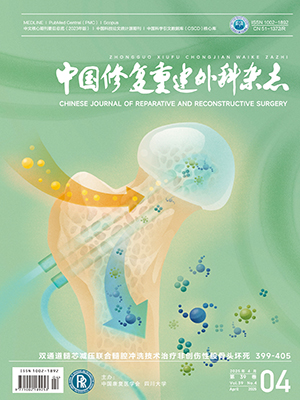| 1. |
Ibrahim T, Rowsell M, Rennie W, et al. Displaced intra-articular calcaneal fractures: 15-year follow-up of a randomised controlled trial of conservative versus operative treatment. Injury, 2007, 38(7): 848-855.
|
| 2. |
Makki D, Alnajjar HM, Walkay S, et al. Osteosynthesis of displaced intra-articular fractures of the calcaneum: a long-term review of 47 cases. J Bone Joint Surg (Br), 2010, 92(5): 693-700.
|
| 3. |
Meraj A, Zahid M, Ahmad S. Management of intraarticular calcaneal fractures by minimally invasive sinus tarsi approach-early results. Malays Orthop J, 2012, 6(1): 13-17.
|
| 4. |
Nosewicz T, Knupp M, Barg A, et al. Mini-open sinus tarsi approach with percutaneous screw fixation of displaced calcaneal fractures: a prospective computed tomography-based study. Foot Ankle Int, 2012, 33(11): 925-933.
|
| 5. |
Kline AJ, Anderson RB, Davis WH, et al. Minimally invasive technique versus an extensile lateral approach for intra-articular calcaneal fractures. Foot Ankle Int, 2013, 34(6): 773-780.
|
| 6. |
Schepers T. The sinus tarsi approach in displaced intra-articular calcaneal fractures: a systematic review. Int Orthop, 2011, 35(5): 697-703.
|
| 7. |
Abdelgawad AA, Kanlic E. Minimally invasive (sinus tarsi) approach for open reduction and internal fixation of intra-articular calcaneus fractures in children: surgical technique and case report of two patients. J Foot Ankle Surg, 2015, 54(1): 135-139.
|
| 8. |
Harnroongroj T, Tangmanasakul A, Choursamran N, et al. Measurement technique of calcaneal varus from axial view radiograph. Indian J Orthop, 2015, 49(2): 223-226.
|
| 9. |
Maskill JD, Bohay DR, Anderson JG. Calcaneus fractures: a review article. Foot Ankle Clin, 2005, 10(3): 463-489, vi.
|
| 10. |
Benirschke SK, Kramer PA. Wound healing complications in closed and open calcaneal fractures. J Orthop Trauma, 2004, 18(1): 1-6.
|
| 11. |
Backes M, Schep NW, Luitse JS, et al. The effect of postoperative wound infections on functional outcome following intra-articular calcaneal fractures. Arch Orthop Trauma Surg, 2015, 135(8): 1045-1052.
|
| 12. |
Schepers T, Den Hartog D, Vogels LM, et al. Extended lateral approach for intra-articular calcaneal fractures: an inverse relationship between surgeon experience and wound complications. J Foot Ankle Surg, 2013, 52(2): 167-171.
|
| 13. |
SooHoo NF, Farng E, Krenek L, et al. Complication rates following operative treatment of calcaneus fractures. Foot Ankle Surg, 2011, 17(4): 233-238.
|
| 14. |
Kikuchi C, Charlton TP, Thordarson DB. Limited sinus tarsi approach for intra-articular calcaneus fractures. Foot Ankle Int, 2013, 34(12): 1689-1694.
|
| 15. |
Epstein N, Chandran S, Chou L. Current concepts review: intra-articular fractures of the calcaneus. Foot Ankle Int, 2012, 33(1): 79-86.
|
| 16. |
Guerado E, Bertrand ML, Cano JR. Management of calcaneal fractures: what have we learnt over the years? Injury, 2012, 43(10): 1640-1650.
|
| 17. |
Yu X, Pang QJ, Chen L, et al. Postoperative complications after closed calcaneus fracture treated by open reduction and internal fixation: a review. J Int Med Res, 2014, 42(1): 17-25.
|
| 18. |
Abdelazeem A, Khedr A, Abousayed M, et al. Management of displaced intra-articular calcaneal fractures using the limited open sinus tarsi approach and fixation by screws only technique. Int Orthop, 2014, 38(3): 601-606.
|
| 19. |
Kwon JY, Guss D, Lin DE, et al. Effect of delay to definitive surgical fixation on wound complications in the treatment of closed, intra-articular calcaneus fractures. Foot Ankle Int, 2015, 36(5): 508-517.
|




